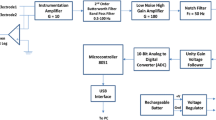Abstract
In this study, we introduce the fast wavelet transform (WT) as a method for investigating the effects of morphine on the electroencephalogram (EEG), respiratory activity and blood pressure in fetal lambs. Morphine was infused intravenously at 25 mg/h. The EEG, respiratory activity and blood pressure signals were analyzed using WT. We performed wavelet decomposition for five sets of parameters D2j where -1 < j ≤ 5. The five series WTs represent the detail signal bandwidths: 1, 16–32 Hz; 2, 8–16 Hz; 3, 4–8 Hz; 4, 2–4 Hz; 5, 1–2 Hz. Before injection of the high-dose morphine, power in the EEG was high in all six frequency bandwidths. The respiratory and blood pressure signals showed common frequency components with respect to time and were coincident with the low-voltage fast activity (LVFA) EEG signal. Respiratory activity was observed during only some of the LVFA periods, and was completely absent during high-voltage slow activity (HVSA) EEG. The respiratory signal showed dominant power in the fourth wavelet band, and less power in the third and fifth bands. The blood pressure signal was also characterized by dominant power in the fourth wavelet band. This power was significantly increased during periods of respiratory activity. There was a strong relationship between fetal EEG, blood pressure and breathing movements. However, the injection of high-dose morphine resulted in a disruption of the normal cyclic pattern between the two EEG states and a significant increase in power in the first wavelet band. In addition, the high-dose drug resulted in a significant increase in the power of respiratory signal in the fourth and fifth wavelet bands, while power was reduced in the third wavelet band. Breathing activity was also continuous after the drug. The high-dose morphine also caused a temporary power shift from the third wavelet band to the fourth wavelet band for the 30-min period after injection of drug. Finally, high-dose morphine completely destroyed the correlation between EEG, breathing and blood pressure signals.
Similar content being viewed by others
References
Akay M, Szeto HH (1994) Investigating the relationship between the EEG, blood pressure respiratory signals in the fetus using fast wavelet transform. Ann Biomed Eng, 574–582
Akay M, Akay YM, Cheng P, Szeto HH (1994a) Time-frequency analysis of the electrocortical activity during maturation using wavelet transform. Biol Cybern 71:169–176
Akay M, Akay YM, Cheng P, Szeto HH (1994b) Investigating the effects of opioid drugs on the ECoG signal during maturation using wavelet transform. Biol Cybern 72:431–437
Cheng PY, Wu D, Soong Y, McCabe S, Decena JA, Szeto HH (1993) Role of μ1 and δ opioid receptors in modulation of fetal EEG and respiratory activity. Am J Physiol 265:R433-R438
Chui CK (1992) An introduction to wavelets. Academic Press, New York
Daubechies I (1988) Orthonormal bases of compactly supported wavelets. Commun Pure Appl Math 909–996
Daubechies I (1990) The wavelet transform, time-frequency localization and signal analysis. IEEE Trans Information Theory 36:961–1005
Garma L, Verley R (1965) Générateurs corticaux studies par électrodes implantées chez le lapin nouveau-né. J Physiol (Paris) 57:811–818
Grossman A, Morlet J (1984) Decomposition of Haar functions into square integrable wavelets of constant shape. SIAM J Math 15: 723–736
Jouvet-Mounier D, Astic L, Lacote D (1970) Ontogenesis of the states of sleep in rat, cat and guinea pig during the first postnatal month. Dev Psychobiol 2:216–239
Locke KW, Holtzman SG (1986) Behavioral effects of opioid peptides selective for mu or delta receptors: locomotor activity in nondependent and morphine-dependent rats. J Pharmacol Exp Ther 238: 997–1003
Mallat SG (1989) A theory for multiresolution signal decomposition: the wavelet representation. IEEE Trans PAMI 7:674–693
Mallat SG, Zhong S (1992) Characterization of signals for multiscale edges. IEEE Trans PAMI 7:710–732
Matejcek M, Pokomy R, Ferber G, Klee H (1988) Effect of morphine on the EEG and other physiological and behavioral parameters. Neuropsychobiology 19:202–211
Novack GD, Winter WD, Nakamura J (1976) EEG and behavioral effects of morphine in dogs. Proc West Pharmacol Soc 19:239–242
Orem J, Barnes CD (1980) Physiology in sleep. Academic Press, New York
Paakkari P, Paakkari I, Siren AI, Feuerstein G (1990) Respiratory and locomotor stimulation by low doses of dermorphin, a mul receptor-mediated effect. J Pharmacol Exp Ther 252:235–240
Szeto HH (1983) Effects of narcotic drugs on fetal behavioral activity: acute methadone exposure. Am J Obstet Gynecol 146:211–217
Szeto HH (1991) Morphine-induced activation of fetal EEG is mediated via central muscarinic pathways. Am J Physiol 260:R509-R517
Szeto HH, Hinman DJ (1985) Prenatal development of sleep-wake patterns in sheep. Sleep 8:347–355
Szeto HH, Vo TDH, Dwyer G, Dogramajian ME, Cox M, Senger G (1985) The ontogeny of fetal lamb electrocortical activity: a power spectral analysis. Am J Obstet Gynecol 153:462–468
Szeto HH, Cheng PY, Decena JA, Wu DL, Cheng Y, Dwyer D (1992a) Development changes in continuity and stability of breathing in the fetal lamb. Am J Physiol 262:R452-R458
Szeto HH, Cheng PY, Decena JA, Wu DL, Cheng Y, Dwyer D (1992b) Fractal properties in fetal breathing dynamics. Am J Physiol 263:R141-R147
Umans JG, Szeto HH (1983) Effects of opiates on fetal behavioral activity in utero. Life Sci 33:639–642
Author information
Authors and Affiliations
Rights and permissions
About this article
Cite this article
Akay, M., Akay, Y.M. & Szeto, H.H. The effects of morphine on the relationship between fetal EEG, breathing and blood pressure signals using fast wavelet transform. Biol. Cybern. 74, 367–372 (1996). https://doi.org/10.1007/BF00194929
Received:
Accepted:
Published:
Issue Date:
DOI: https://doi.org/10.1007/BF00194929




